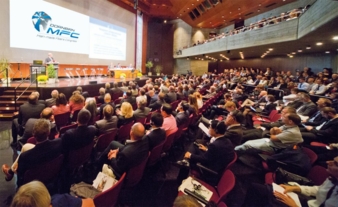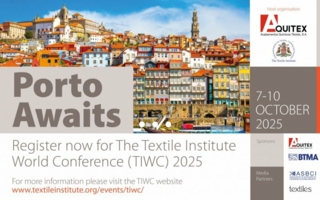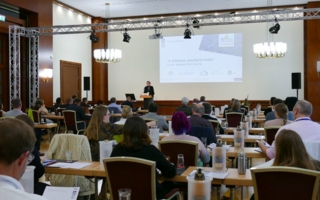18/12/2017 – International Fibres Congress Dornbirn — auf Deutsch lesen
A Sea of Plastics ...
A contemplative synthetic fibres industry!
The annual international fibres congress saw a man-made fibres industry that is trying to establish itself between justification and forward-thinking strategies when it comes to sustainability. Product innovation and process optimisation are key to achieving this.
Climate change, human rights and world peace
The “trilemma of the modern world”, as Franz Josef Radermacher from the Institute of Databases and Artificial Intelligence at Ulm University calls it – require a change in our thinking. Radermacher was one of the approx. 100 speakers at the International Fibres Congress in Dornbirn, Austria (13–15 September 2017). An advocate for fair globalisation, he considers sustainability to be the only solution that will provide adequate living conditions for the growing world population (nine billion people by 2050 according to the OECD). The fibres industry, which produced 75 % man-made fibres, 24 % cotton and 1 % wool in 2016 (CIRFS), is also faced with this responsibility, and is stepping up to the mark. However, Dornbirn also showed that the synthetic fibres industry in particular faces the challenge of thinking ahead, while having to continue competing for public favour against “organic” and “natural”.
In his speech Wilhelm Rauch, Managing Director at IVC (Industrievereinigung Chemiefasern) in Frankfurt a.M., Germany, compared the consumption of water, energy and land use for man-made fibres with the production of natural fibres and presented possibilities for recycling cellulose and synthetic fibres. His conclusion: “Quickly dismissing man-made fibres according to the credo ‘nature beats chemistry’ isn’t justified as synthetic fibres demonstrate an overall better ecological balance sheet than cotton.”
Plastic waste
Another pressing problem facing the chemicals industry is plastic waste accumulating in the oceans. Synthetic fibres experts are pushing for further studies in order to gain a clear and reliable picture on whether textiles such as polar fleece (from textured microfibres) or products made from synthetic staple fibres (with low pilling) and their fibre losses, e. g. through washing, pose a risk to humans and animals. So far, there is no indication that this is the case. Innovative products, such as the wet wipes made from Violoft, a special viscose fibre by Kelheimer, suitable for flushing due to its high solubility, are pointing the way ahead. Violoft has already been awarded the “OK biodegradable MARINE” certificate by the Belgian certification organisation Vinçotte.
Also paving the way for the future are circular systems. The EU has already started the “Circular-Economy-Initiative”. Prior to the congress in Dornbirn, industry, brand and commercial representatives attended the “Circular Economy Dornbirn” workshop to discuss the status quo and identify fields of action. Companies such as Lenzing (Austria), which produces Lyocell materials and the recycled cellulose fibre “Refibra” made from 80 % wood pulp and 20 % waste cotton are industry role models.
According to recent studies in Germany, hemp could become an annually renewable plant source for cellulose used in the Lyocell process. Other organisations are investigating possibilities such as “textile recycling with enzymes” (University of Natural Resources and Life Sciences in Vienna, Austria and the Institute for Environmental Biotechnology in Tulln, Austria). Biopolymers are also moving forward. The Bielefeld University of Applied Sciences in Germany is working on “nanofibres from biopolymers – ‘Green Electrospinning’ of functional nonwovens”, while Avalon Industries AG in Zug, Switzerland, is studying sugar-based 5-HMF-polymers for formaldehyde-free packaging and composites, among others.
The medical field
In the medical field, the congress showcased thread constructions for the development of biosensors for chronic wounds (TU Dresden, Germany and ITM Dresden, Germany) as well as textile-based implants and nano-capsules for the development of functional textiles in the health industry. The Hohenstein Institute for Textile Innovation (Germany) shed light on new methods for testing protective welding apparel for its UV protection. Meanwhile, energy absorbing fibres could optimise impact protection, and fibres or yarns comprising electroactive polymers could function as capacitors and piezoelectric components. Looking at process technologies, Tory Industry Inc. in Shizuoka, Japan, introduced its melt spinning technology for manufacturing nanofibres.
Next year
57th Dornbirn Congress, 12–14 September 2018
Next year’s main topics are: fibre innovations, transport and mobility, recycling, energy storage, surface modification and additives, additives technologies
Regine Hövelmann





